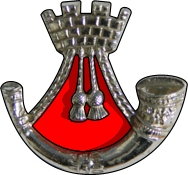|
Somerset and Cornwall Light Infantry
  The Somerset and Cornwall Light Infantry (SCLI) was a light infantry regiment of the British Army. It was formed in October 1959 by the merger of the Somerset Light Infantry and the Duke of Cornwall's Light Infantry, and was itself merged with three other regiments of the Light Infantry Brigade in 1968 to form The Light Infantry. HistoryThe regiment was formed in 1959 by the merger of two regiments: the Somerset Light Infantry and the Duke of Cornwall's Light Infantry. Immediately before amalgamation the 1st Battalions of these regiments were stationed at Warminster and Osnabrück, respectively. The 1st Battalion The Somerset and Cornwall Light Infantry served at Osnabrück until June 1961 as part of the BAOR, when it moved to Gibraltar. Gibraltar Day is now celebrated annually on 6 October as the Regimental Day of Somerset and Cornwall Light Infantry.[1] The regiment brought colours and insignia from its parent regiments: the Royal Blue Facings and Royal Bugle Cords of the Somerset Light Infantry, the red patch commemorating the red feathers of the Light Company of the 46th Foot (later the 2nd Battalion the Duke of Cornwall's Light Infantry) and the privilege of wearing the sash knotted on the right side, a unique distinction usually associated with the gallantry of the 13th Foot at Culloden. The green head-dress, whistle cord and No 1 Dress Uniform are common to all Light Infantry Regiments. The parent Regiments were raised: in 1685 as Huntingdon's Foot, in 1702, as Fox's Marines, and in 1740 as the 57th (later renumbered 46th) (1st and 2nd Battalions The Duke of Cornwall's Light Infantry).[2]
In 1968 it was amalgamated with the three other regiments of the Light Infantry Brigade to form The Light Infantry.[3] Nicknames for the regiment included Pierce's Dragoons, The Bleeders, The Illustrious Garrison and The Yellow-banded Robbers.[4] Postings The first posting of the newly formed regiment was to Osnabrück in Western Germany as part of the 12th Armoured Infantry Brigade. The first commanding officer of the regiment was Lt. Col. W.R. Lawson MBE, from October 1959 to April 1960. He was followed by Lt. Col. W. Hine-Haycock, who was in charge from April 1960 to September 1962. When this tour of duty ended, the battalion was moved to Seaton Barracks at Plymouth.[1]  The next posting was to Gibraltar where the battalion undertook ceremonial duties including the Ceremony of the Keys, mounting guard at the Governor's residence and at the Border crossing with Spain, which included a perimeter patrol. While at Gibraltar, the battalion provided a company strength contingent to garrison RAF El Adem at Tobruk.[1]   The next posting took the regiment to Berlin between 1963 and 1965. During this period, Lt. Col. John Howard was in charge, followed by Lt. Col. G. Mathews. In November 1965 the regiment returned to Britain and was stationed at the Gravesend Barracks. During this period, the battalion was part of the brigade force that was on permanent standby to be flown anywhere in the world at 72 hours' notice.[1]  In April 1966 the regiment was posted to Aden, a British protectorate, where extremists calling themselves the Aden National Liberation Front, battled for the independence of Aden by forcing the British out. During this posting, two servicemen were lost, one when his vehicle was blown up and the other when he was hit in the head by a piece of shrapnel from an exploding grenade.[1] Battle honours


Civic honours
Notable membersRecipients of the British Empire Medal for Gallentry One soldier of the SCLI was awarded the BEM: Colour Sergeant Robert "Bobby" Bogan[5][6] Regimental chapelsChurch of St. Mary Magdalene, Taunton, Somerset The South Aisle contains a Book of Remembrance in an oak desk of those who fell in the 1939–45 War, and memorials to those who fell in the 1914–18 War, The Boer War, Chitral, The Crimea, The Afghan Campaign, Maharajpore and the American War of Independence. St. Petroc's Church, Bodmin, Cornwall The Regimental Chapel in the Soldiers' Aisle was dedicated on 13 August 1933. It contains memorials to those who fought in the Boer War and a Roll of Honour to those who fell in the 1939–45 War. It also contains all the old Colours of the 32nd and 46th Foot except the Waterloo Colours which are now in Dunstaffnage Castle, Argyllshire, having been given to Lieutenant Alexander Campbell in memory of his father, who was Colonel of the Regiment at that time. Collect O GOD, FOR AS MUCH AS WE ARE ALL MEMBERS OF ONE BODY, AND WHEN SOME ARE HONOURED ALL REJOICE WITH THEM. GRANT TO US OF THE SOMERSET AND CORNWALL LIGHT INFANTRY THE SPIRIT OF UNITY AND BROTHERLY LOVE, THAT WE MAY ONE AND ALL LOVE AND SERVE THEE WITH ALL OUR HEARTS, REJOICING ABOVE ALL ELSE TO GIVE HONOUR TO THEE: THROUGH JESUS CHRIST OUR SAVIOUR, WHO LIVETH AND REIGHNETH WITH THEE AND THE HOLY SPIRIT, EVER ONE GOD, WORLD WITHOUT END . Regimental colonels Colonels of the Regiment were:[7]
References
External linksWikimedia Commons has media related to Somerset and Cornwall Light Infantry. |
||||||||||||||||||||||||||||||||||||
